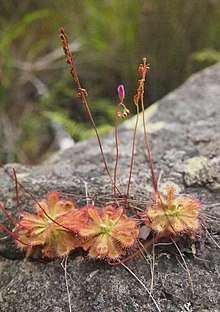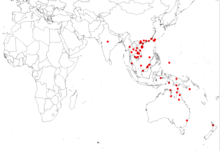Drosera burmannii
Drosera burmannii, the tropical sundew,[1][2] is a small, compact species in the carnivorous plant genus Drosera. Its natural geographical range includes Australia, India, Taiwan, China, Japan, and southeast Asia.[3] It normally spans only 2 cm (0.8 in) in diameter. It is one of the fastest trapping sundews as well, and its leaves can curl around an insect in only a few seconds, compared to the minutes or hours it takes other sundews to surround their prey. In nature, D. burmannii is an annual, but in cultivation, when grown indoors during the cold months, it can live for many years. Since D. burmannii is an annual, it produces large amounts of seed.[3] Drosera burrmannii has been considered a powerful rubefacient in Ayurveda.[4]
| Drosera burmannii | |
|---|---|
 | |
| Drosera burmannii | |
| Scientific classification | |
| Kingdom: | Plantae |
| Clade: | Tracheophytes |
| Clade: | Angiosperms |
| Clade: | Eudicots |
| Order: | Caryophyllales |
| Family: | Droseraceae |
| Genus: | Drosera |
| Subgenus: | Drosera subg. Thelocalyx |
| Species: | D. burmannii |
| Binomial name | |
| Drosera burmannii | |
 | |
| Occurrence data from AVH and GBIF | |
| Synonyms | |
Drosera burmannii is an herb that produces very short stems and leaves in a rosette. Each wedge-shaped leaf is typically 8–10 mm long and 5–6 mm wide. White flowers are produced in groups of 3 to 10 on 6–15 cm (2–6 in) tall racemose inflorescences, of which there can be one to three per plant.[5]
The first brief description of the species was written by Paul Hermann and published after Hermann's death by William Sherard in Musaeum Zeylanicum. It was described in more detail by Johannes Burman in his 1737 publication on the flora of Ceylon. Burman used the polynomial Ros solis foliis circa radicem in orbem dispositis,[6] but the species was not formally published until 1794 when Martin Vahl named it in honor of Burman as Drosera burmanni (the species epithet is usually orthographically corrected to burmannii). In 1871 Heinrich Gustav Reichenbach described a new species, D. dietrichiana, named after its discoverer Amalie Dietrich. In his 1906 monograph of the Droseraceae, Ludwig Diels reduced this species to a variety of D. burmannii. This variety was described as being a larger and more robust plant than D. burmannii var. burmannii. Both D. dietrichiana and the variety are now considered synonyms of D. burmannii.[2][7]
See also
References
- "Drosera burmanni". FloraBase. Western Australian Government Department of Parks and Wildlife.
- Erickson, Rica. 1968. Plants of Prey in Australia. Lamb Paterson Pty. Ltd.: Osborne Park, Western Australia.
- Brittnacher, John. "Growing Drosera burmannii and D. sessilifolia". International Carnivorous Plant Society. Retrieved 31 October 2016.
- Lewis, Walter H., 1977 Medical Botany - Plants Affecting Man's Health. John Wiley & Sons, St. Louis, Missouri.
- Marchant, N. G., and George, A. S. 1982. Droseraceae. Flora of Australia, Vol. 8. pp. 9-64.
- Burman, Johannes. 1737. Thesaurus zeylanicus, exhibens plantas in insula Zeylana nascentes. Amsterdam. p. 207.
- Schlauer, J. 2009. World Carnivorous Plant List - Nomenclatural Synopsis of Carnivorous Phanerogamous Plants. Accessed online: 12 September 2009.
External links
![]()